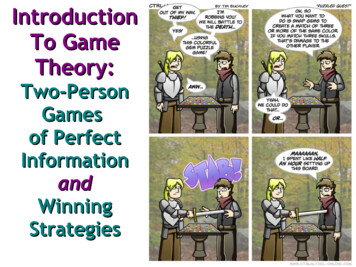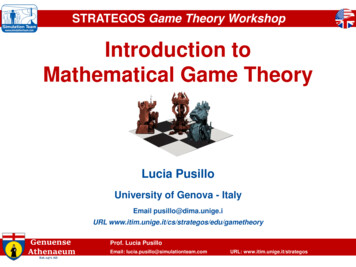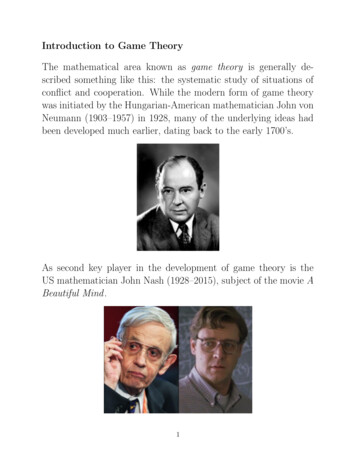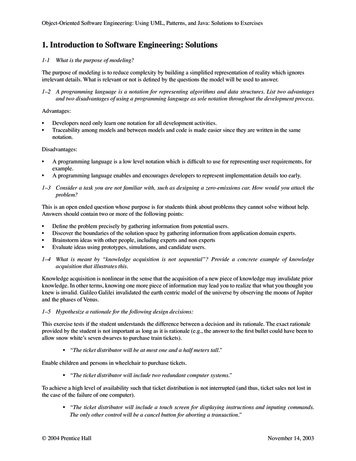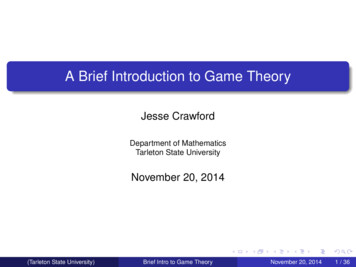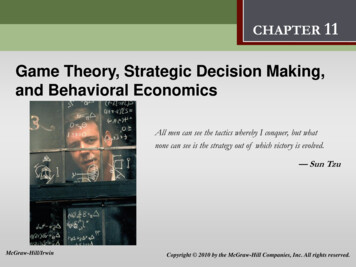
Transcription
Game Theory, Strategic DecisionMaking , and Behavioral Economics11CHAPTER 11Game Theory, Strategic Decision Making,and Behavioral EconomicsAll men can see the tactics whereby I conquer, but whatnone can see is the strategy out of which victory is evolved.— Sun TzuMcGraw-Hill/IrwinCopyright 2010 by the McGraw-Hill Companies, Inc. All rights reserved.
11Game Theory, Strategic DecisionMaking , and Behavioral EconomicsGame Theory and the Economic Way of Thinking Game theory is formal economic reasoningapplied to situations in which decisions areinterdependent Game theory is a very flexible tool thatallows us to develop more precise models ofsituations that involve strategic interactionsMcGraw-Hill/IrwinColander, Economics2
Game Theory, Strategic DecisionMaking , and Behavioral Economics11Game Theory and the Economic Way of Thinking Formal game theory assumptions: Players are fully forward looking Players always behave in a manner thatgives them the highest payoff Players expect all other players to behave inthe same manner11-3
11Game Theory, Strategic DecisionMaking , and Behavioral EconomicsGame Theory and Oligopolies Game theory is most commonly applied tooligopolies Oligopolies can produce similar ordifferentiated goods (cars, steel, etc) Oligopolies are interdependent since theycompete with only a few other firmsMcGraw-Hill/IrwinColander, Economics4
11Game Theory, Strategic DecisionMaking , and Behavioral EconomicsGame Theory and Oligopolies Their pricing and output decisions must bestrategic to avoid economic losses—theirdecisions are mutually interdependent Game theory helps us analyze their strategiesMcGraw-Hill/IrwinColander, Economics5
11Game Theory, Strategic DecisionMaking , and Behavioral EconomicsPayoff Matrix Payoff matrix: a table that shows theoutcome of every choice by every player,given the possible choices of all other players The payoff matrix has three elements:1. Players2. Strategies3. PayoffsMcGraw-Hill/IrwinColander, Economics6
Game Theory, Strategic DecisionMaking , and Behavioral Economics11Payoff MatrixThis is a payoff matrix for Firm A and Firm B and their profits. Thefirst entry in each cell column represents Firm A’s profits and thesecond entry in each cell represents Firm B’s profits.Firm BRaise PriceFirm ALower PriceRaisePrice 100, 80 80, 90LowerPrice 90, 75 70, 8011-7
Game Theory, Strategic DecisionMaking , and Behavioral Economics11Payoff MatrixThe easiest way to analyze which strategy is best is to start with oneplayer at a time. We will “box” Firm A’s strategies and analyze themfirst.Firm BRaise PriceFirm ALower PriceRaisePrice 100, 80 80, 90LowerPrice 90, 75 70, 8011-8
Game Theory, Strategic DecisionMaking , and Behavioral Economics11Payoff MatrixStep 1: We will use an X to identify which strategy is best for Firm A. If Firm B raises its price, Firm A can raise its price for 100 in profit,or lower its price for 90 in profit. If Firm B lowers its price, Firm A can raise its price for 80 in profit, orlower its price for 70 in profit.Firm BRaise PriceXFirm ALower PriceXRaisePrice 100, 80 80, 90LowerPrice 90, 75 70, 8011-9
Game Theory, Strategic DecisionMaking , and Behavioral Economics11Payoff MatrixStep 2: We will use a to identify which strategy is best for Firm B. If Firm A raises its price, Firm B can raise its price for 80 in profit, orlower its price for 90 in profit. If Firm A lowers its price, Firm B can raise its price for 75 in profit, orlower its price for 80 in profit.Firm BRaise PriceXFirm ALower PriceX RaisePrice 100, 80 80, 90LowerPrice 90, 75 70, 80 11-10
Game Theory, Strategic DecisionMaking , and Behavioral Economics11Payoff MatrixWhat is the best strategy for each Firm given the other player’schoice? Firm A’s best strategy is to raise price. Firm B’s best strategy is to lower price.Firm BRaise PriceXFirm ALower PriceX RaisePrice 100, 80 80, 90LowerPrice 90, 75 70, 80 11-11
Game Theory, Strategic DecisionMaking , and Behavioral Economics11Payoff MatrixFirm BRaise PriceXFirm ARaisePriceLowerPrice 100, 80 90, 75XLower PriceX 80, 90 70, 80X Raise, RaiseRaise, LowerLower, Raise Lower, Lower11-12
Game Theory, Strategic DecisionMaking , and Behavioral Economics11Dominant Strategy In the previous example, both Firm A and Bhave a dominant strategy: the decision(strategy) you will make regardless of whatyour opponent does When looking at two firms, they may or maynot have a dominant strategy If there is not a dominant strategy, the firm isdependent on what the other firm does11-13
Game Theory, Strategic DecisionMaking , and Behavioral EconomicsDominant Strategy We look at the rows and columns to determine a dominant strategy. Since Firm A will raise its price no matter what Firm B does, its dominantstrategy is to raise its price. Since Firm B will lower its price no matter whatFirm A does, its dominant strategy is to lower its price.Firm BXXFirm AMcGraw-Hill/Irwin Colander, Economics1411
Game Theory, Strategic DecisionMaking , and Behavioral EconomicsNash Equilibrium A Nash equilibrium means no player canimprove his or her payoff by changing his/herstrategy on their own A Nash equilibrium doesn’t have to be thesolution that is jointly best for all players This appears when there is an “x” and a“ ” in one of the boxes of the matrix—thiswould be the decision each player/firmmakesMcGraw-Hill/IrwinColander, Economics1511
Game Theory, Strategic DecisionMaking , and Behavioral Economics11Nash Equilibrium Below, there is a Nash equilibrium:Firm BRaise PriceXFirm ALower PriceX RaisePrice 100, 80 80, 90LowerPrice 90, 75 70, 80 11-16
Game Theory, Strategic DecisionMaking , and Behavioral Economics11The Prisoner's Dilemma The prisoner’s dilemma is a 2 person noncooperative game that demonstrates thedifficulty of cooperative behavior11-17
Game Theory, Strategic DecisionMaking , and Behavioral EconomicsThe Prisoner's Dilemma: Example “If both you and the other prisoner confess, insteadof being sentenced to the maximum 10 years inprison, the two of you will each serve only 5 years injail. Further, if you confess and the other prisonerdoes not confess, in exchange for your serving as awitness for the prosecution, we will drop the chargesfor the lesser felony, and you will be set free. If,however, you don’t confess and the other suspectdoes, you will be sentenced to the maximum 10years in prison. If neither confesses, both will becharged with the lesser felony and serve 6 months.”McGraw-Hill/IrwinColander, Economics1811
Game Theory, Strategic DecisionMaking , and Behavioral Economics11Application: The Prisoner's DilemmaThis is a payoff matrix for Prisoner A and B. The first entry in eachcell column represents Prisoner A’s options and the second entryin each cell represents Prisoner B’s options.BCONFESSCONFESSDON’TCONFESS5 years for A, 5 years for BA goes free, 10 years for B10 years for A, B goes free6 months for A, 6 months for BADON’TCONFESS11-19
Game Theory, Strategic DecisionMaking , and Behavioral Economics11Application: The Prisoner's DilemmaThe easiest way to analyze is to start with one player at atime. We will “box” Prisoner A’s strategies and analyzethem first.BCONFESSCONFESSDON’TCONFESS5 years for A, 5 years for BA goes free, 10 years for B10 years for A, B goes free6 months for A, 6 months for BADON’TCONFESS11-20
Game Theory, Strategic DecisionMaking , and Behavioral Economics11Application: The Prisoner's DilemmaStep 1: We will use an X to identify which strategy is best for Prisoner A. If Prisoner B confesses, Prisoner A can confess for 5 years or notconfess for 10 years. If Prisoner B does not confess, Prisoner A can confess and go free ordon’t confess for 6 months.BDON’TCONFESSXCONFESSCONFESS X5 years for A, 5 years for BA goes free, 10 years for B free10 years for A, B goes6 months for A, 6 months for BADON’TCONFESS11-21
Game Theory, Strategic DecisionMaking , and Behavioral Economics11Application: The Prisoner's DilemmaStep 2: We will use a to identify which strategy is best for Prisoner B. If Prisoner A confesses, Prisoner B can confess for 5 years or notconfess for 10 years. If Prisoner A does not confess, Prisoner B can confess and go free ordon’t confess for 6 months.BDON’TCONFESSXCONFESSCONFESS X5 years for A, 5 years for BA goes free, 10 years for B free10 years for A, B goes6 months for A, 6 months for BADON’TCONFESS11-22
11Game Theory, Strategic DecisionMaking , and Behavioral EconomicsApplication: The Prisoner's Dilemma What is the best strategy for each Prisoner given the otherPrisoner’s choice? What is the outcome? Here, 5 years for Prisoner A and 5 years for Prisoner B is the bestoutcome.CONFESSCONFESSXBDON’TCONFESSX 5 years for A, 5 years for BA goes free, 10 years for B free10 years for A, B goes6 months for A, 6 months for BADON’TCONFESS11-23
Game Theory, Strategic DecisionMaking , and Behavioral EconomicsApplication: The Prisoner's Dilemma Why? Although not confessing is the best outcome forprisoner A and B, they cannot count on each othernot to confess As a result, the best combined outcome for themwould be for each to confess and serve 5 yearsMcGraw-Hill/IrwinColander, Economics2411
Game Theory, Strategic DecisionMaking , and Behavioral EconomicsExample: The Game Theory Framework Four “A” students partied the night before anexam and slept through the exam They tell the professor that the reason theymissed the exam was that they were all in acar that had a flat tire The professor lets them make up the examMcGraw-Hill/IrwinColander, Economics2511
Game Theory, Strategic DecisionMaking , and Behavioral EconomicsExample: The Game Theory Framework The exam had two questions: an essayrelating to the course material and ascreening question which tire was flat? This is a screening question: its purpose isto reveal strategic information about theperson who answersMcGraw-Hill/IrwinColander, Economics2611
Game Theory, Strategic DecisionMaking , and Behavioral Economics11An Overview of Game Theory as a Toolin Studying Strategic Interaction A non-cooperative game is a game in whicheach player is out for him- or herself andagreements are either not possible or notenforceable Cooperative games are games in whichplayers can form coalitions and the coalitioncan enforce its will on its members11-27
Game Theory, Strategic DecisionMaking , and Behavioral EconomicsAn Overview of Game Theory as a Toolin Studying Strategic Interaction Sequential games are games where playersmake decisions one after another Example: Chess Simultaneous move games are games whereplayers make their decisions at the same timeas other players (for example, the prisoner’sdilemma)McGraw-Hill/IrwinColander, Economics2811
Game Theory, Strategic DecisionMaking , and Behavioral Economics11Strategies of Players Backward induction: you begin with a desiredoutcome and then determine the decisionsthat could have led you to that outcome11-29
Game Theory, Strategic DecisionMaking , and Behavioral EconomicsStrategies of Players A dominant strategy is a strategy that ispreferred by a player regardless of theopponent’s move Ex: Prisoner’s dilemma A mixed strategy is a strategy of choosingrandomly among moves Ex: Rock, paper, scissorsMcGraw-Hill/IrwinColander, Economics3011
Game Theory, Strategic DecisionMaking , and Behavioral Economics11Informal Game Theory and Modern Behavioral Economics Informal game theory is often calledbehavioral game theory because it relies onempirical observation, not deductive logicalone, to determine the likely choices ofindividuals So it provides a framework forapproaching questions11-31
Game Theory, Strategic DecisionMaking , and Behavioral Economics11Behavioral Economics and Game Theory Behavioral economists use experiments andhave people play the formal games to explorethe validity of the assumptions in formalgame theory and how they might be revised11-32
Game Theory, Strategic DecisionMaking , and Behavioral EconomicsLoss Aversion, Incorrect Inference, and FramingEffects Framing effects are the tendency of people tobase their choices on how the choice ispresented An early-bird special is a betteradvertisement than a surcharge for peaktime meals Would you choose option A of saving 200of 600 lives, or option B that will end livesof 400 of 600?McGraw-Hill/IrwinColander, Economics3311
Game Theory, Strategic DecisionMaking , and Behavioral Economics11Chapter Summary Game theory is a flexible approach that is useful whendecisions are interdependent In the prisoner’s dilemma game both players have adominant strategy that leads to a jointly undesirableoutcome A payoff matrix provides a summary of each player’sstrategies and how the outcomes of their choices depend onthe actions of the other players A Nash equilibrium is an equilibrium of a game that resultsfrom a non-cooperative game when each player plays his orher best strategy11-34
Game Theory, Strategic DecisionMaking , and Behavioral Economics11Chapter Summary A dominant strategy is preferred regardless of one’s opponent’smove. A mixed strategy is choosing randomly Behavioral economics examines deviations between formalgame theoretical predictions and actual outcomes of games Loss aversion and framing effects are examples of findings inbehavioral economics that challenge the traditional model’spredictions The traditional model remains relevant because it only takes afew people to realize that money has been left on the table forthe results of the standard model to hold11-35
Game Theory and the Economic Way of Thinking Game theory is formal economic reasoning applied to situations in which decisions are interdependent Game theory is a very flexible tool that allows us to develop more precise models of situations that involve strat
